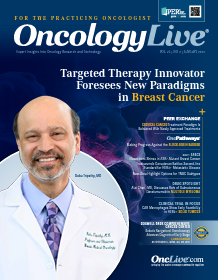Publication
Article
Robotic Navigational Bronchoscopy Advances Diagnosis of Early-Stage Lung Cancer
Author(s):
Nathaniel Ivanick, MD, FCCP, explains advancements in the use of robotic navigational bronchoscopy for the diagnosis of early-stage lung cancer.
Nathaniel Ivanick, MD, FCCP

Navigational bronchoscopy seeks to overcome the challenges of conventional bronchoscopy, which is limited by the size and flexibility of the scope. Navigational bronchoscopy can be used during peripheral nodule biopsy for small, difficult-to-reach lung nodules that are typically not accessible using conventional bronchoscopy.
Between the windpipe and alveoli, the airways branch 17 to 24 times. Most bronchoscopes can only reach 4 or 5 of these airway divides because of the diameter of the remaining airways and limited flexibility of the scope. This results in conventional bronchoscopy being limited to the outer one-third of the lung and it carries a diagnostic accuracy of 31%.1 Diagnostic accuracy has increased with the application of updated ultrasound technology, such as radial endobronchial ultrasound and early navigational systems, reaching the 50% level in larger health care centers.2 As these ranges were still considered unacceptably low, a push for further advancements, including robotic bronchoscopy, has enhanced the diagnostic yield.
What Is Navigational Bronchoscopy?
Navigational bronchoscopy can be thought of as a global positioning system (GPS) for the bronchoscopist. Similar to a GPS device leading a driver to a distant, unfamiliar city via state highways, then down district roads and eventually city streets, a navigational bronchoscope uses a weak electromagnetic field to triangulate the positions of chest sensors, a field generator, and the scope tip to determine the biopsy location and help drive the scope to the target. Navigational bronchoscopy can be combined with virtual bronchoscopy by running a high-resolution CT scan through imaging software to “map out” the airway.
The power of robotic navigational bronchoscopy ensures increased reach, stability, and vision. The robotic scopes on the market have been demonstrated to extend an average of 4 airway branch points farther than existing ultrathin scopes.3 This is because of cables throughout the length of the scope that are capable of articulation, in contrast to conventional scopes which can only articulate within the last 5 cm of the scope. This articulation can be locked into place, such that a bronchoscopist can step back from the table and review slides or discuss findings without fear of the scope changing position.
The ability to lock a scope in place is a tremendous improvement over existing technologies, which can lose position during instrument insertion or as the plastic parts warmed to body temperature. Further, with the Monarch platform, for example, maintenance of scope vision out to the periphery of the lung enables the visualization of peripheral tumors before biopsy. It is therefore no surprise that the diagnostic accuracy of such procedures jumped to the mid-80% range when using navigational bronchoscopy.4
Who Needs Robotic Navigational Bronchoscopy?
We have an “epidemic” of lung nodules in the United States, with a tremendous number found each year. Between 2006 and 2012, before lung cancer screening was widely adopted, more than 1.5 million lung nodules were identified in Americans undergoing CT scans.5
Any patient with a suspicious pulmonary nodule is a candidate for robotic bronchoscopy, with the final determination dependent on the level of suspicion of lung cancer, size of the nodule, and proximity to the edge of the lung. Although robotic bronchoscopy has a slightly lower diagnostic yield than a CT-guided biopsy, it has the advantage of a slightly lower complication rate and the ability to stage the mediastinum in the same procedure.
What Is the Future of Robotic Navigational Bronchoscopy?
What new robotic navigational bronchoscopy technologies are on the horizon? I very much look forward to new systems that will enhance both diagnostic yield and treatment effectiveness. Using a robotic navigational bronchoscope and cone-beam CT, which provides a more accurate cross-sectional image directly before biopsy, interventional pulmonologists are demonstrating diagnostic yields that will rival those of CT-guided biopsies.6
Treatments that may be considered for peripheral nodules include microwave ablation, photodynamic therapy, or direct injection of chemotherapeutics into the nodules. These treatments could be combined with other modalities, including surgery or radiation, to advance the field and improve lung cancer survival.
References
- Baaklini WA, Reinoso MS, Gorin AB, Sharafkaneh A, Manian P. Diagnostic yield of fiberoptic bronchoscopy in evaluating solitary pulmonary nodules. Chest. 2000;117(4):1049-1054. doi:10.1378/chest.117.4.1049
- Ost DE, Ernst A, Lei X, et al; AQuIRE Bronchoscopy Registry. Diagnos-tic yield and complications of bronchoscopy for peripheral lung lesions. Results of the AQuIRE Registry. Am J Respir Crit Care Med. 2016;193(1):68-77. doi:10.1164/rccm.201507-1332OC
- Chen AC, Gillespie CT. Robotic endoscopic airway challenge: REACH assessment. Ann Thorac Surg. 2018;106(1):293-297. doi:10.1016/j.athoracsur.2018.01.051
- Wagh A, Ho E, Murgu S, Hogarth DK. Improving diagnostic yield of navigational bronchoscopy for peripheral pulmonary lesions: a review of advancing technology. J Thorac Dis. 2020;12(12):7683-7690. doi:10.21037/jtd-2020-abpd-003
- Gould MK, Tang T, Liu ILA, et al. Recent trends in the identifica-tion of incidental pulmonary nodules. Am J Respir Crit Care Med. 2015;192(10):1208-1214. doi:10.1164/rccm.201505-0990OC
- Benn BS, Romero AO, Lum M, Krishna G. Robotic-assisted navigation bronchoscopy as a paradigm shift in peripheral lung access. Lung. 2021;199(2):177-186. doi:10.1007/s00408-021-00421-1

Latest Conference Coverage

RVU120 Shows Early Promise in R/R Metastatic or Advanced Solid Tumors

The WEE1 Inhibitor APR-1051 Shows Early Safety and Tolerability in Advanced, Mutated Solid Tumors

TYRA-300 Is Safe, Generates Preliminary Antitumor Activity in FGFR3+ Metastatic Urothelial Cancer

Experts Highlight Noteworthy Research From the 2024 ESMO Congress
2 Commerce Drive
Cranbury, NJ 08512





